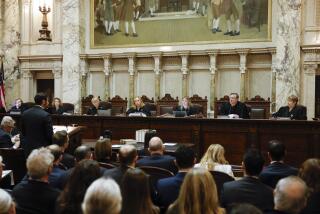Panel’s final redistricting maps drawn
Reporting from Los Angeles and Sacramento -- In a historic first, a citizens commission set new boundaries for California’s congressional and legislative districts, reshaping the political landscape into more competitive terrain that could transform the state’s usual dynamic of rancor and gridlock.
The new maps, which are intended to govern elections for most of the next decade, would force several entrenched partisan legislators — those who have been deep blue or deep red — to face more moderate political districts.
Some lawmakers, who had been in safe districts where reelection was all but guaranteed for party hard-liners, now find themselves facing a more mixed electorate in districts that are more “purple” than red or blue.
The commission’s goal to more fairly reflect the state’s existing communities and increasing diversity grew out of voters’ frustration with gridlock in Sacramento, where even the most common-sense policies have been held hostage by hyper-partisan lawmakers.
The panel’s work already has elected officials scurrying for seats in new districts or pondering retirement. Experts say the maps displace at least 60 elected officials in California from their districts or set them up for tough reelection battles.
Most seats in the state Legislature will remain firmly Republican or Democrat, with the Democrats positioned to capture the coveted two-thirds majority of one house of the Legislature. One drawback: Newly competitive districts could leave lawmakers more reliant on special interest campaign dollars to stay in office.
But in a statehouse where just a couple of votes can change the balance of power on key policy issues, even small changes could have a major impact.
“We lost a decade in terms of making policy in California,” said Fred Keeley, a former Democratic assemblyman from Santa Cruz who helped draft the redistricting initiative. “Maybe this will give us a fighting chance at a better outcome.”
The maps, which include new district boundaries for State Board of Equalization elections, were approved by the Citizens Redistricting Commission on Friday morning and now move into a 14-day public review period, during which only minor, technical changescan be made before the final commission vote Aug. 15.
“For the first time ever, Californians will know exactly who drew the maps, how they were drawn and for what reason, and they know their voices were heard,” Helen Hutchison, vice president of the League of Women Voters of California, told the commission during its meeting Friday.
But challenges loom. Some have vowed to undo the new districts through the courts or by referendum.
“It’s not over yet,” said U.S. Rep. Gary G. Miller (R-Diamond Bar), whose home was placed in the same district as fellow Republican Ed Royce of Fullerton. “Judges will make the decision…. What they’ve done to so many districts out there makes no sense.”
Rep. Jerry Lewis (R-Redlands) — dean of California House Republicans, whose home was thrown into the same district as a Democratic incumbent — said: “I believe this will not be the final chapter in the 2011 redistricting saga.”
The new maps could cost Republicans a handful of seats in Congress, as well as enough seats in the state Senate for Democrats to command the two-thirds majority that would give them complete control of the house, and enough votes to pass tax measures.
California Republican Party officials say they have not decided what, if any, action to take. A challenge to the district lines could result in the courts redrawing the boundaries. But that carries a risk: There is no guarantee the courts wouldn’t draw lines even worse for the GOP.
At a news conference Friday at the state Capitol, commissioners said they would aggressively defend their plan against legal challenges.
“In complying with the law, the commission is confident that these maps will prevail against any and all legal challenges,” said Chairwoman Connie Galambos Malloy. “We also believe that the new districts will be upheld in the court of public opinion.”
Those who championed redistricting reform as a means of easing the dysfunction in Sacramento are optimistic about the possibility of an emerging purple power.
Historically, moderates have helped tip the scales on critical issues in the Legislature. They can kill legislation by withholding key committee votes and cut deals in tax debates.
The new maps already appear to be influencing some lawmakers.
This year, while both parties dug in their heels over the state budget, five Republican senators, facing the prospect of more competitive districts, bucked party leadership and the majority of their GOP colleagues to negotiate with Gov. Jerry Brown on a proposal to renew billions of dollars in expiring tax hikes. In return, they sought an overhaul of public pensions, a cap on state spending and a loosening of environmental regulations.
While both sides deadlocked on details and Brown failed to get the necessary GOP votes, an influx of moderate lawmakers could reignite the debate with a Democratic governor who has expressed a desire to tackle pension and regulatory issues his party has sidestepped for years.
But whether that rise of purple districts will create a more moderate, responsive body of lawmakers is a matter being hotly debated in Sacramento.
“It will all be one big experiment happening at one time,” said Matt Rexroad, a Republican political consultant who advises clients on redistricting.
While many elected officials won’t be able to take their constituents for granted any longer, forcing more outreach and potentially responsiveness, more competitive districts mean more expensive elections.
Candidates will have to turn to deep-pocketed donors to fund them, potentially making those legislators even more beholden to narrow special interests than ever before.
“Winning a competitive district takes money more than it takes moderation,” said Thad Kousser, a political scientist at UC San Diego. “There’s this incentive to stake out the positions that will allow you to raise the $2 million to $5 million it will take to compete. And the people that are able to raise that kind of money are generally in one camp or the other.”
Partisans from all camps were unanimous in their assessment that drawing the new maps was a gut-wrenching process with high stakes.
“It has been difficult, to say the least, to respond to the moving targets your maps have been,” Erica Teasley Linnick of the African American Redistricting Collaborative told the commission Friday.
Earlier versions of the maps threatened to do away with at least one of three Los Angeles County congressional districts where African Americans represent a plurality of voters.
Groups fearful of losing political power pressured the commission into numerous, sometimes dramatic reworkings of its maps.
Commissioners were required to create districts of equal population and adhere to the federal Voting Rights Act, which protects minorities’ opportunities to elect representatives of their choosing, as well try to keep communities of interest together, among other criteria. None of it was easy in a state as large, complex and rapidly changing as California.
Among those who gained the most from the process were Latino activists, who demanded more districts where Latinos represent a majority of voters. They said the surge of the Latino population over the last decade cried out for such a change. The maps released Friday reflect 10 new legislative and congressional seats where Latinos command a majority.
The 14-member commission — made up of five Republicans, five Democrats and four members unaffiliated with any political party —was nearly unanimous in its support of the new lines.
A Republican member from Anaheim was the only commissioner to oppose all the maps. One other commissioner, a Republican from Norco, voted against just the proposed congressional districts.
Times staff writers Patrick McGreevy and Anthony York contributed from Sacramento. Times staff writer Richard Simon contributed from Washington.
More to Read
Start your day right
Sign up for Essential California for news, features and recommendations from the L.A. Times and beyond in your inbox six days a week.
You may occasionally receive promotional content from the Los Angeles Times.







